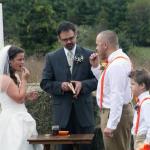This blog post and the previous one are word studies on the household and house in ancient Israel.[1] The family and home used to be the center of society, something we seem to have forgotten over the ages. Perhaps these posts will serve as a brief reminder of the family at the center of the good life.
The Father’s House
The houses in ancient Israel are distinct. In fact, architecture shows that they are unique among Israel’s neighboring nations. The house of Israel was a different type of structure.
i. Israel’s physical house and the priority of family
The Father’s House
A common term in the Hebrew Bible for house literally means the Father’s Household or Father’s House. It’s called the bet’ab. In the bet’ab or physical structure, they would live together for generations.
We see this in some regions of America, usually correlating with different demographics. We see multiple generations living together, and not killing each other . . . it happens . . . it’s possible.
Up to three generations live in the bet’ab, up to thirty members.[2] These are just estimates.
Design of the Father’s House
The design of the Father’s House is even unique. If you were to enter one of these houses, you would enter through a gate. There would be a large outer court and an inner court. It would be shared by the many families.[3] There might be four or five families there, living in this area.
It’s called the “Four-room, pillared house.” Surrounding the courtyard, there would be individual units for families to live in.[4] We might call them little apartments.
The bet’ab would have combined family living spaces, like a family room. There would be a combined reception room and a combined kitchen, which probably always faired well for the men. It doesn’t hurt for the household cooks to exchange recipes. Then the sleeping apartments (units) would surround these common areas.
There would often be two floors. So the first floor is the common area. There would be stalls for animals that the family needs close by all the time. There would be food storage and a courtyard.
The second floor would be living quarters, possibly a patio roof, where they would gather, spend some time, and barbecue.[5]
The entire living space is centered around the family.
I’ve really spent some time thinking about this in relation to our families today.
Questions:
What do our homes look like?
We probably still organize our homes around our priorities, but what are our priorities?
Is our TV on a pedestal surrounded by candles, made into a sacred shrine, so we can all come into the living room and kneel every day? Is that the center of our home?
How do we organize our living space? What does that tell us about the priorities in our home?
How do we organize our time during the week?
How do we organize the structured areas of our lives and does it reflect the love of God for our family?
So Solomon says, and this is the Ingle Paraphrase . . .
ii. “The LORD must build the house or else it’s pointless”
As Solomon says this (Psalm 127.1) the Jews would naturally think of the bedrock of their society, which is the Father’s House.
Those words of Solomon must ring true today.
Questions:
What type of house are we building for our families and our lives?
Are we intermingling our faith and family, or is it all segmented?
Is our house structured with the Lord at the center of our home?
Are we letting the Lord build our houses, our families?
notes:
[1] as previously published: Rev. Jared V. Ingle, Psalm 127: Unless the LORD builds the house (sermon, MT. ZION Family Worship Center, Traverse City, MI, July 26, 2014).The Household in Ancient Israel
[2] Sandra L. Richter, The Epic of Eden: A Christian Entry into the Old Testament (Downers Grove, IL: IVP Academic, 2008), 26.Amazon: Epic of Eden
[3] Alfred Edersheim, Sketches of Jewish Social Life (Peabody, MA: Hendrickson, 2009), 93.
Amazon: Sketches of Jewish Social Life













